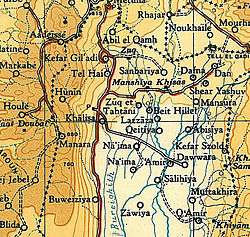Dafna
| Dafna | |
|---|---|
 Dafna | |
| Coordinates: 33°13′48″N 35°38′19″E / 33.23000°N 35.63861°ECoordinates: 33°13′48″N 35°38′19″E / 33.23000°N 35.63861°E | |
| District | Northern |
| Council | Upper Galilee |
| Affiliation | Kibbutz Movement |
| Founded | 3 May 1939 |
| Founded by | Dror and Kibbutz HaMeuhad |
| Population (2015) | 908[1] |
| Website | www.dafna.org.il |


Dafna (Hebrew: דַּפְנָה) is a kibbutz in the Upper Galilee in northern Israel, 7 km east of Kiryat Shmona. It was founded on 3 May 1939 under the tower and stockade system, and was the first tower and stockade settlement in the northern Hula Valley. Dan and Dafna are known as "the Ussishkin Fortresses". Three streams of the river Dan surround the landscape.
Education
Har Vagai (mountain and valley), one of the junior and senior regional high schools, is located in kibbutz Dafna. The school has 900-1000 pupils from 7th to 12th grade. The school covers an area of about 1 km square and the river Dan runs through the middle of the school grounds. The pupils are drawn from neighbouring kibbutzim, Dan, HaGoshrim, Kfar Szold, Snir and from other settlements such as Rosh Pinna, Metula and Yesud HaMa'ala.
The school holds a memorial service and educational seminar every year to commemorate the 73 soldiers who were lost in the helicopter disaster of 4 February 1997. The elementary school for the kibbutz children is Aley Giva (atop a hill) which is situated in Kibbutz Kfar Giladi. The children from Dafna are taken by bus there and back every day. There is a thriving education system of kindergartens for young children from the age of 6 months up to 6 years when they start the first year of school.
Economy
Dafna Industries was founded 1964 and is today one of the leading footwear exporters of Israel. Its products are exported to Europe, North and South America. Owing to a downturn in the world economy the factory went through a difficult period and was eventually sold to another Israeli footwear manufacturer Teva Neot with Dafna retaining a percentage of the shares.
Additional economic activities, which are part of the revenue producing activities of the kibbutz, are: Apple, avocado and grapefruit orchards, cotton growing, dairy cattle and commercial fish ponds and renting accommodation. In addition, the tourist guest house "Ganei Dafna" (Garden of Dafna) offers recreational diversion.
The kibbutz also runs a fish restaurant and camping ground where visitors can pitch their tents next to the river and enjoy a grilled trout in the restaurant nearby. Dafna cooperated with Dan in establishing the first trout-breeding enterprise in the area.
History
The original settlers were immigrants mostly from Poland and Lithuania.[2] In 1947, it had a population of 600.[2]
After the 1948 Palestine war, Dafna took over part of the land belonging to the newly depopulated Palestinian village of Al-Sanbariyya.[3]
According to a 1949 book by the Jewish National Fund, Dafna along with other border settlements of Dan and Kfar Szold held off the Syrian and Lebanese forces during the 1948 Arab-Israeli war. However, the settlement was often bombarded and was said to have suffered heavy damage.[2]
Kibbutz Dafna figures prominently in Leon Uris's book Exodus, as the hometown of the protagonist Ari Ben Caanan.

1997 Israeli helicopter disaster
On 4 February 1997, at approximately 19:00, two "Yasur" Sikorsky CH 53 helicopters carrying 73 soldiers and loaded with ammunition collided in mid-air over She'ar Yashuv. One of the helicopters smashed into an open field near the cemetery of Dafna.[4] It is believed that this accident increased the pressure on the IDF to withdraw its forces from Lebanon, finally done in May 2000.[5]
Today a monument next to the cemetery of Dafna commemorates the 73 fallen soldiers. The monument consists of 73 obelisks and a running stream of water that leads, via a path of glass and stone to a huge tree whose leaves symbolize the names of those killed in the disaster. It is visited by many Israelis throughout the year.
References
- ↑ "List of localities, in Alphabetical order" (PDF). Israel Central Bureau of Statistics. Retrieved 16 October 2016.
- 1 2 3 Jewish National Fund (1949). Jewish Villages in Israel. Jerusalem: Hamadpis Liphshitz Press. p. 29.
- ↑ Khalidi, Walid (1992). All That Remains:The Palestinian Villages Occupied and Depopulated by Israel in 1948. Washington D.C.: Institute for Palestine Studies. p. 494. ISBN 0-88728-224-5.
- ↑ Al menos 73 soldados israelíes mueren al colisionar dos helicópteros militares en el aire El Mundo, 5 February 1997 (Spanish)
- ↑ The movement that shaped the Lebanon pullout The Jerusalem Post, 8 June 2000 (republished on Women and Mothers for Peace)
External links
- Official website (Hebrew)
- Guest house
- Har Vagai School